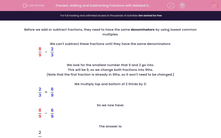Before we add or subtract fractions, they need to have the same denominators by using lowest common multiples.
We can't subtract these fractions until they have the same denominators:
| 8 | - | 2 |
| 9 | 3 |
We look for the smallest number that 9 and 3 go into.
This will be 9, so we change both fractions into 9ths.
(Note that the first fraction is already in 9ths, so it won't need to be changed.)
We multiply top and bottom of 2 thirds by 3:
| 2 | = | 6 |
| 3 | 9 |
So we now have:
| 8 | - | 6 |
| 9 | 9 |
The answer is:
| 2 |
| 9 |
Example
Work out the following, remembering to give your answer in its lowest terms.
| 7 | + | 4 |
| 15 | 30 |
Answer
The lowest common multiple of 15 and 30 is 30, because 2 × 15 = 30.
We multiply top and bottom of 7 fifteenths by 2:
| 7 | = | 14 |
| 15 | 30 |
So we now have:
| 14 | + | 4 |
| 30 | 30 |
This gives:
| 18 |
| 30 |
But this must be reduced by dividing top and bottom by 2.
The answer is:
| 9 |
| 15 |
which we write as 9/15.








